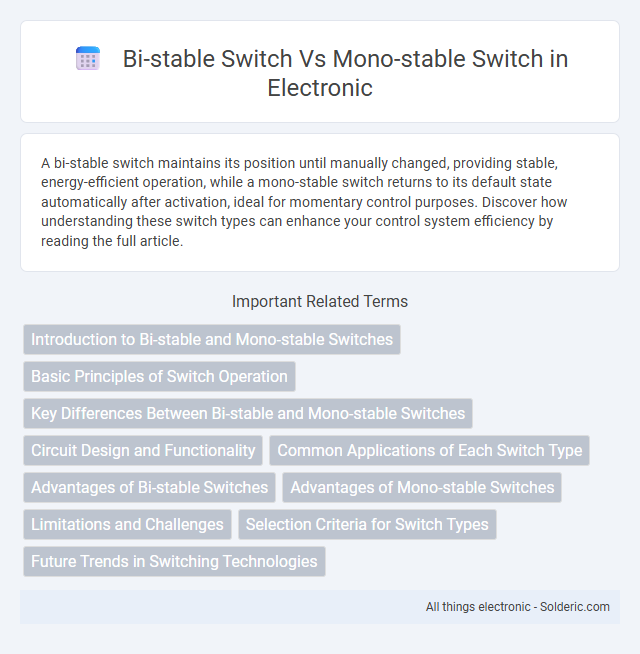A bi-stable switch maintains its position until manually changed, providing stable, energy-efficient operation, while a mono-stable switch returns to its default state automatically after activation, ideal for momentary control purposes. Discover how understanding these switch types can enhance your control system efficiency by reading the full article.
Comparison Table
| Feature | Bi-Stable Switch | Mono-Stable Switch |
|---|---|---|
| Definition | Maintains its state until manually changed | Returns to default state automatically after activation |
| State Retention | Retains position without power | Temporary state; reverts once released |
| Typical Usage | Light switches, toggle controls | Push buttons, doorbells |
| Mechanical Design | Two stable positions | One stable position with spring return |
| Power Consumption | Minimal, no continuous power needed | Power used only during activation |
| Example | Rocker switch | Momentary push-button |
Introduction to Bi-stable and Mono-stable Switches
Bi-stable switches maintain two stable states without continuous power, toggling between ON and OFF positions upon activation, making them ideal for memory storage and toggle applications. Mono-stable switches return to a single stable state after being activated, functioning like momentary push-buttons commonly used in reset or doorbell circuits. Understanding these operational differences is crucial for designing circuits requiring either sustained or temporary state changes.
Basic Principles of Switch Operation
Bi-stable switches maintain two stable states, ON and OFF, using a latching mechanism that preserves the switch position without continuous power. Mono-stable switches return to a default position automatically after actuation, relying on springs or internal mechanisms for resetting. These fundamental operational differences influence power consumption, stability, and usability in electronic and mechanical applications.
Key Differences Between Bi-stable and Mono-stable Switches
Bi-stable switches maintain their state after being actuated, requiring a second action to change back, while mono-stable switches return to their default position immediately after being pressed. The key difference lies in their stability: bi-stable switches are ideal for applications needing persistent on/off states, whereas mono-stable switches suit momentary control functions. Understanding these distinctions helps you select the appropriate switch type for your electrical or electronic projects.
Circuit Design and Functionality
Bi-stable switches maintain their state indefinitely until triggered to change, requiring complex circuit design with feedback loops to ensure stable operation. Mono-stable switches automatically return to their default state after a set time, relying on timing components like capacitors or resistors for functionality. Your choice between bi-stable and mono-stable switches impacts circuit complexity and the type of control needed for specific applications.
Common Applications of Each Switch Type
Bi-stable switches are commonly used in applications requiring memory retention, such as power tools, lighting controls, and toggle switches for maintaining an on or off state without continuous power. Mono-stable switches find frequent use in devices needing momentary activation, including keyboards, push-button doorbells, and reset buttons on electronics. Your choice between these switches depends on whether the application requires a maintained position or temporary activation.
Advantages of Bi-stable Switches
Bi-stable switches maintain their state without continuous power, resulting in energy efficiency and reduced heat generation. Your devices benefit from increased reliability and longer operational life due to minimal wear on switching components. This makes bi-stable switches ideal for battery-powered and low-energy applications requiring stable on/off conditions.
Advantages of Mono-stable Switches
Mono-stable switches offer advantages such as simplicity in design and reliable momentary contact operation, making them ideal for applications requiring temporary activation like push buttons or reset functions. Their low power consumption and ease of integration with electronic circuits facilitate efficient control in systems with frequent switching needs. Mono-stable switches provide immediate response with minimal mechanical wear, enhancing durability in high-reset or momentary signal environments.
Limitations and Challenges
Bi-stable switches face challenges in maintaining stable states without continuous power, requiring precise mechanical and electrical design to prevent unintentional toggling and ensuring reliable performance under varying environmental conditions. Mono-stable switches, while simpler, have limitations including the need for constant activation to maintain the output state and susceptibility to signal noise that may cause false triggers or unintended resets. Both switch types must address issues related to durability, sensitivity to external interference, and integration constraints in complex electronic systems.
Selection Criteria for Switch Types
Bi-stable switches are ideal for applications requiring a maintained on/off state without continuous power, making them suitable for energy-efficient designs and long-term state retention. Mono-stable switches are better for momentary actions where the switch returns to its default state once released, perfect for reset functions or short-term activations. Your choice depends on whether you need a stable, latched output or a temporary, self-resetting operation.
Future Trends in Switching Technologies
Bi-stable switches offer energy-efficient, non-volatile states ideal for emerging low-power IoT devices and smart home applications, while mono-stable switches provide fast, momentary control essential for responsive industrial automation and tactile feedback systems. Advances in materials like graphene and MEMS technology are driving miniaturization and enhanced durability in both switch types, enabling integration into flexible electronics and wearable technology. Future trends emphasize hybrid switching solutions combining bi-stability with rapid reset capabilities to optimize performance in adaptive and reconfigurable systems.
Bi-stable switch vs Mono-stable switch Infographic

 solderic.com
solderic.com